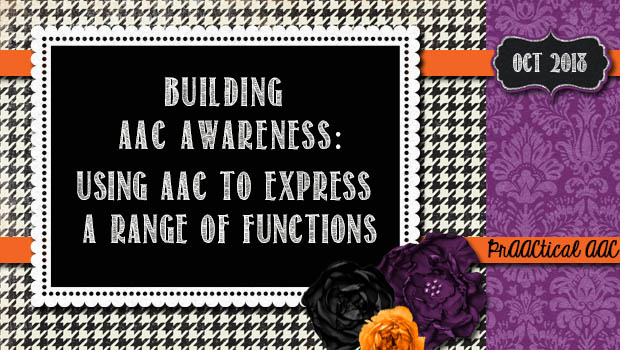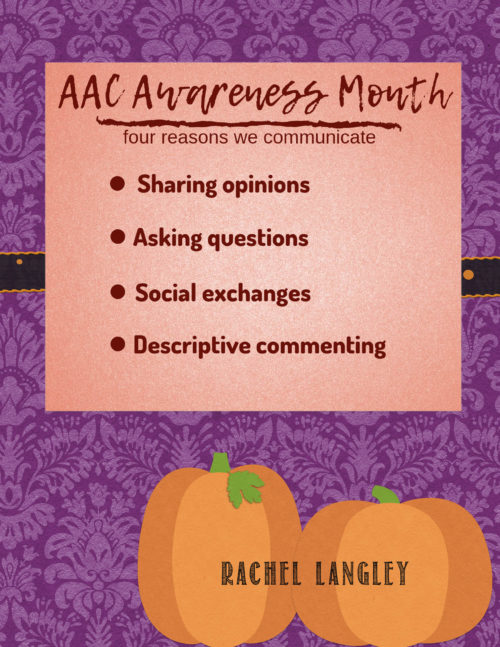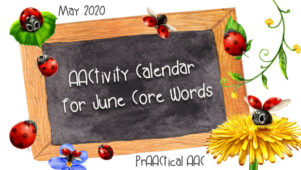Building AAC Awareness: Using AAC to Express a Range of Functions

 Most times, the goal of AAC intervention is to help those with complex communication needs be able to express whatever they want at any time. For some individuals, we over-emphasize the tools and strategies they will need to get the things they want, whether it is social engagement (attention), assistance (help), objects, events, or even being able to protest or reject unwanted situations. Michigan-based SLP Rachael Langley works tirelessly to support technologies and services that give access to the full range to communicative functions. When she offered to share her thoughts on this topic with us, we jumped on the chance.
Most times, the goal of AAC intervention is to help those with complex communication needs be able to express whatever they want at any time. For some individuals, we over-emphasize the tools and strategies they will need to get the things they want, whether it is social engagement (attention), assistance (help), objects, events, or even being able to protest or reject unwanted situations. Michigan-based SLP Rachael Langley works tirelessly to support technologies and services that give access to the full range to communicative functions. When she offered to share her thoughts on this topic with us, we jumped on the chance.
Enjoy!
::::::::::::::::::::::::::::::::::::::::::::::::::::::::::::::::::::::::::::::::::::::::::::::::::::::::::::::::::::::::::::::::::::::::::::::::::

Four Functions of Language
There are many ways to emphasize AAC use and embed aided language into the day. Sometimes we use a core vocabulary approach to teach specific vocabulary. But we can also approach AAC learning by focusing on a specific function or pragmatic use of language.
To recognize AAC awareness month this October, let’s highlight a few ways that we can use AAC and teach our learners to use
AAC in novel ways. To be clear, this is not an extensive list of all the ways we use language. For additional lists with many more functions of language, please check the AAC Language Lab (here) and a checklist by Keisha Tipton on AAC Girls (here). If you are using the PODD communication system, which is organized pragmatically, you may find THIS resource from helpful from Interactive Speech Pathology.
For this month, let’s highlight about one function per week. Notice that “requesting” is not one of the “reasons we communicate” that I’ve chosen to highlight. This is intentional, as we often see an over-reliance on using AAC for requesting. This is especially true in the early stages of implementation. There is so much more to communication than just requesting
- Sharing Opinions: It’s human nature to have opinions and to communicate them to others. Even for people who are non-speaking or pre-verbal, we can typically tell some of their preferences and opinions based on unconventional ways to communicate (e.g. turning away, a look of disgust, smiling, reaching, etc). Focus on simple ways to model whether you “LIKE” or “DON’T LIKE” something. Even on a basic core vocabulary board, like the one provided by Project Core, you can say “NOT LIKE” or “LIKE.” You can say “GOOD” or “NOT GOOD.” Using a robust communication app, learners will likely have access to far more opinion words. Create opportunities that invite their input. Read a ridiculous book and ask, “What do you think?” Wear some sports gear of the rival team in your area and see if that gets the conversation going! Encourage others to use AAC to model sharing their opinions.
- Asking Questions: So often we ask, ask, ask our learners questions… but are we teaching them to ask questions? Or are we testing them? Be aware of how you use “questions” when providing AAC instruction. Instead of asking, “Which one is it?” or “What do you want?”, try building opportunities for natural questions to occur. Instead of introducing the activity for the day by showing, bring it in a bag or in a box. Model, “What is in there?” or “Where is it?” As you review a schedule or introduce a new activity, model “WHEN” it is happening. We aren’t asking questions about information we already know. We are teaching our learners to seek information they need.
- Social Exchanges: Take some time to really look at your learner’s AAC and see what type of social comments they have available. If all they have access to is, “Hello” and “Goodbye” and “My name is___,” this might be an opportunity to add more age-appropriate social exchanges. Too often, younger kids through young adults have access to the social language pre-set by adults, which is sometimes overly-formal. What are peers saying? Go to the cafeteria and sample the crowd. Work with the learner to see which words or phrases they’d like: “Hey bro!” “Later.” “YOLO!” “Gotta bounce.” “Epic fail.” Using relatable, age-sensitive social language makes AAC much more interesting and authentic to many learners. It’s on fleek.
- Descriptive Commenting: It’s time to find your best adjectives! This could be as simple as adding colors, size, or quality words to comments (e.g. Good book! Little cookie). Or it could be using an adjective to describe an outfit, a book, or a situation (e.g. Silly! Big, fun hat). For more ideas on using flexible, high-frequency words to describe things, look into the descriptive teaching model by Gail Van Tatenhove. Another great source of information on this topic is Erin Sheldon, who builds upon Gail’s work with using core vocabulary for descriptive teaching. There’s a lot of power in using core vocabulary to describe everyday concepts.
::::::::::::::::::::::::::::::::::::::::::::::::::::::::::::::::::::::::::::::::::::::::::::::::::::::::::::::::::::::::::
About the Guest Author
SLP Rachael Langley has been working in the public schools as a speech-language pathologist for over 15 years. As as an AAC Specialist in central Michigan, Rachael strives to spread the message about the importance of AAC and unlocking the communication potential of all students, both in Michigan and in the wider AAC community. She has been a frequent presence on PrAACtical AAC, contributing calendars of activity suggestions for core word learners as well as several guest posts. You can learn more from Rachael here.
Filed under: Featured Posts, PrAACtical Thinking
Tagged With: beyond requesting, communicative functions, Rachael Langley
This post was written by Carole Zangari




